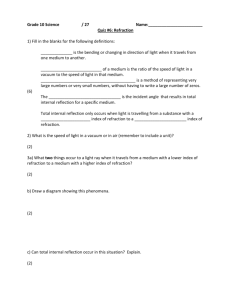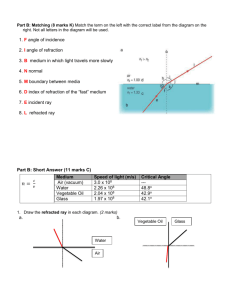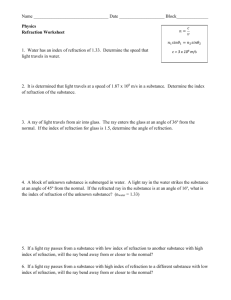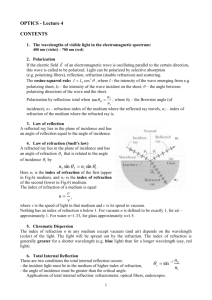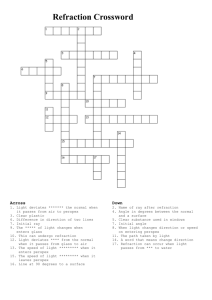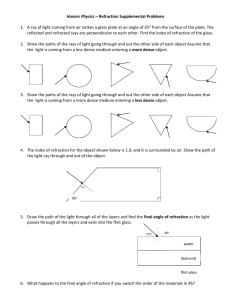Grade 10 Academic Science – Optics – (Physics) Refraction Science
advertisement
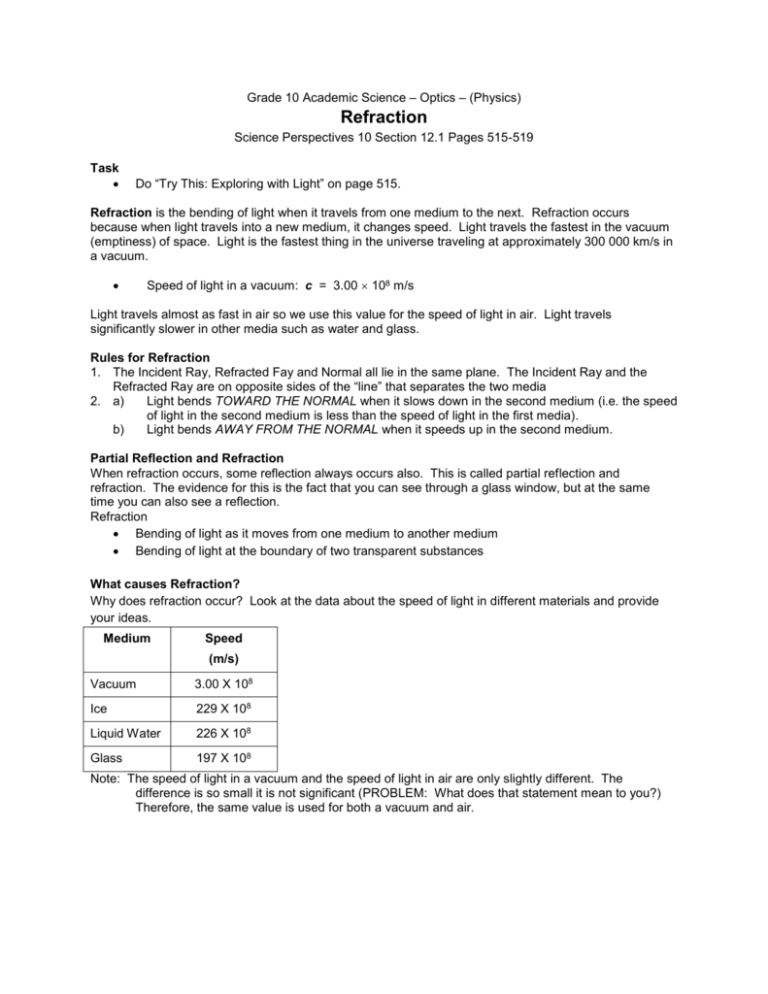
Grade 10 Academic Science – Optics – (Physics) Refraction Science Perspectives 10 Section 12.1 Pages 515-519 Task Do “Try This: Exploring with Light” on page 515. Refraction is the bending of light when it travels from one medium to the next. Refraction occurs because when light travels into a new medium, it changes speed. Light travels the fastest in the vacuum (emptiness) of space. Light is the fastest thing in the universe traveling at approximately 300 000 km/s in a vacuum. Speed of light in a vacuum: c = 3.00 108 m/s Light travels almost as fast in air so we use this value for the speed of light in air. Light travels significantly slower in other media such as water and glass. Rules for Refraction 1. The Incident Ray, Refracted Fay and Normal all lie in the same plane. The Incident Ray and the Refracted Ray are on opposite sides of the “line” that separates the two media 2. a) Light bends TOWARD THE NORMAL when it slows down in the second medium (i.e. the speed of light in the second medium is less than the speed of light in the first media). b) Light bends AWAY FROM THE NORMAL when it speeds up in the second medium. Partial Reflection and Refraction When refraction occurs, some reflection always occurs also. This is called partial reflection and refraction. The evidence for this is the fact that you can see through a glass window, but at the same time you can also see a reflection. Refraction Bending of light as it moves from one medium to another medium Bending of light at the boundary of two transparent substances What causes Refraction? Why does refraction occur? Look at the data about the speed of light in different materials and provide your ideas. Medium Speed (m/s) Vacuum 3.00 X 108 Ice 229 X 108 Liquid Water 226 X 108 Glass 197 X 108 Note: The speed of light in a vacuum and the speed of light in air are only slightly different. The difference is so small it is not significant (PROBLEM: What does that statement mean to you?) Therefore, the same value is used for both a vacuum and air. Rules for Refraction When a ray moves from a FAST MEDIUM to a SLOW MEDIUM (see illustration), the ANGLE OF REFRACTION approaches the Normal When a ray travels from a SLOW MEDIUM to a FAST MEDIUM, the Refracted Ray moves away from the Norm The Incident Ray and the Refracted Ray are on the OPPOSITE SIDES of the Boundary and the OPPOSITE SIDES of the Normal. When you see a straw refracted in water, you are looking at a VIRTUAL IMAGE. Why? Total Internal Reflection When light rays travel from water (a slow medium) to air (a fast medium), the rays bend (i.e., refract) AWAY from the Normal. Refraction of light waves in water. X represents the actual position of a straw in water. Y represents the apparent position of the pencil. This occurs when the Angle of Refraction > the Angle of Incident What happens when the Angle of Refraction = 90O? In the diagram, this is “C” and it is called the CRITICAL ANGLE. When the Angle of Incident > Critical Angle, there is TOTAL INTERNAL REFLECTION (i.e., no transmission of light from the water). The process is illustrated below. How does light travel through an OPTIC CABLE? HINT: Total Internal Reflection How does a diamond sparkle so much? Partial Reflection and Refraction Refraction is often accompanied by reflection. A reflection on water is a good example. This is Partial Reflection and Refraction HOMEWORK Questions 1-7 Page 519 Science Perspectives 10



